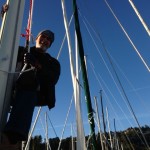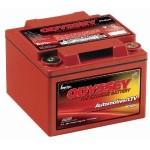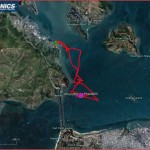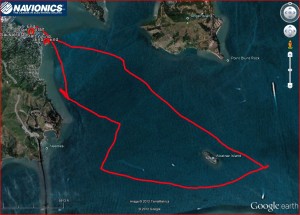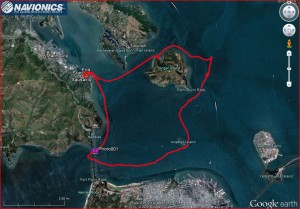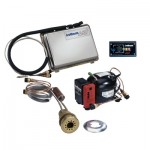So, it was a difficult decision to determine where we would take our precious Cool Change for her first boatyard experience. KKMI has always been considered the gold standard, and they had recently opened a boatyard near us in Sausalito – very convenient. However, they were one of the most expensive yards in the Bay Area, and a friend of ours had had some negative experiences with the original KKMI in Richmond. But, we decided that for these jobs, they appeared competent, and we really liked the convenience. After dropping off Cool Change at KKMI in Sausalito on October 14, we spent hours discussing with the boatyard what needed to be done and how much they were going to charge us for it. Our initial request was for a bottom job, the replacement of a few thru-hulls, and the installation of a dripless shaft seal. Those were all jobs best done by a boatyard. Rick then decided that maybe KKMI might do a better job than he could of installing the refrigeration unit, so we discussed that with them. Their charge for that service was way over the top, until Rick knocked off 10 hours of labor by saying he would do the electrical installation of the refrigerator himself. (It ended up taking Rick only 1 1/2 hours). Anyway, KKMI had numerous excuses for why they were delayed in their efforts, and then the refrigerator unit had to be replaced with a smaller one sent from back East, so the whole thing ended up taking 6 weeks instead of two.
We finally went to pick up Cool Change at the KKMI dock on October 26. What a fiasco!
As planned, we arrived at the boatyard dock late on Friday night after KKMI closed for the weekend. Rather than motoring over to our slip that night when we were tired, the plan was to sleep on her at the boatyard dock on Friday night, and then take her out sailing from there on Saturday morning.
On Saturday morning at first light, we peeked out on our deck and found the deck surface to be filthy. I suppose sitting outside in a boatyard for over a month, a boat can pick up a lot of stray dust, paint particles, soot, etc., but this was disgusting. No one had bothered to clean her up, it seemed. She was coated with a greasy, grimy layer, at places ground into the surface by repeated scufs of big boots, especially in the cockpit. We couldn’t wait to clean her up, but first, we wanted to get as far away from that boatyard as possible.
As soon as Cindy put her into gear, there was a HORRIBLE sound and extreme vibration throughout the boat. Cindy put it back into neutral immediately, and Rick went down below to check it out. We briefly put it into gear again, and Rick saw the entire propeller shaft vibrating like it was going to shake itself right out of the boat. Our first thought was, didn’t anyone think to operate the shaft and propeller after having replaced the shaft seal and taken the propeller off and on? Wouldn’t that be standard procedure? There was NO EXCUSE for this!
After smoke stopped steaming out of Rick’s ears, he wrote a terse but polite email to our KKMI Project Manager. Apparently, Rick’s anger and urgency showed through the email, because within about 2 hours, the Project Manager showed up at the dock on his day off. That was encouraging. But then, without even asking to listen for himself to what happened when we put the boat in gear, he proceeded to stand on the dock for several minutes, lecturing us about how whatever was going on couldn’t possibly have been caused by KKMI, and that the most likely explanation was that we brought our boat in that way! He said they never check the operation of the shaft after changing the shaft seal or removing the propeller because there is never any reason to – nothing ever goes wrong. In any case, there was nothing he could do over the weekend, and they would haul it back out on Monday to see if they could identify the cause of the problem. Meanwhile, our plans for sailing were foiled.
While the Project Manager was there, Rick also showed him the ghastly, childlike attempt at dressing the excess copper tubing from the refrigeration system in the locker beneath the head sink. Rick literally said that a 10 year old child could have done it better. It looked like a nest of copper spagetti. The Project Manager was as aghast as Rick was, and had no excuse except to say that it would be fixed also.
Rick was beside himself. Fortunately, the owner of a deisel engine repair shop next to KKMI happened to be in his yard on his day off, so Rick asked him if he wouldn’t mind coming by to look at the problem. Rick wanted to rule out the accusation that there was something wrong with our engine. The deisel shop owner’s diagnosis was a highly likely probability that KKMI put the propeller blades back on at the wrong pitch. He compared it to trying to start a car in fifth gear. He looked down through the water from the dock at the propeller and could tell the blades were pitched improperly.
After an incredible ordeal and much frustration, KKMI finally admitted on the following Monday that they had put the propeller back on wrong. They fixed it, and even called the propeller manufacturer to make sure they were doing it right. They took a video of the shaft rotating smoothly, and sent it to us! They also dressed the copper tubing the way it should be. I had paintakingly scrubbed the entire deck and had left cardboard mats in all of the stepping places, and KKMI respected my attempt to keep the boat clean by not dirtying it again. And because it is a three hour drive for us to come down a second time just to move the boat back to our own slip, KKMI moved the boat back for us. We were almost to the point where we might possibly be able to be at peace with using them again, since they had at least made it all right, and then ….
We arrived at the boat the next weekend, once again to go sailing. When I looked at the helm, and there was something wrong with the gear shift lever. On our boat, we have two levers at the helm; one for the throttle and one for the gear. The throttle lever is straight up in nuetral, and forward for more power, but never is the throttle lever pulled aft. But, someone had. They had obviously forced the throttle lever in a direction it didn’t go – it must have taken quite some effort to do so; not something you would do accidentally. There is a saying on sailboats – if it doesn’t move smoothly, don’t force it – instead, take your time and find out what is stopping it from moving smoothly. Otherwise, you are sure to break something. Well, they broke something, all right. We had to take the helm apart and reset the throttle lever in its proper position. Fortunately, one of our dockmates, Dan, spent his life on the ocean in charge of engine systems so he made quick work of the job. Wanting to give KKMI the benefit of the doubt that somehow there was an explanation for all of this, Rick wrote the Project Manager another email. He never responded.
It was not all bad, however. In the end, Cool Change had a new refrigeration system, two new thru-hulls, a bottom job and a dripless shaft seal, all installed properly, and we were able to repair their throttle damage without permanent injury. Best of all, Rick learned that even the “gold standard” of boatyards screws up sometimes, and that he has as good a likelihood of doing it right as they do. The refrigeration system, once we saw how it was installed, was certainly something we could have done ourselves, and Rick would have dressed the copper tubing properly the first time. If only we have enough time, I am confident that many of the projects we have left to do, we can do ourselves. And boosting our confidence of doing it ourselves will help us not only to save money, but also to be better informed about our boat when no boatyards are around to help us.

